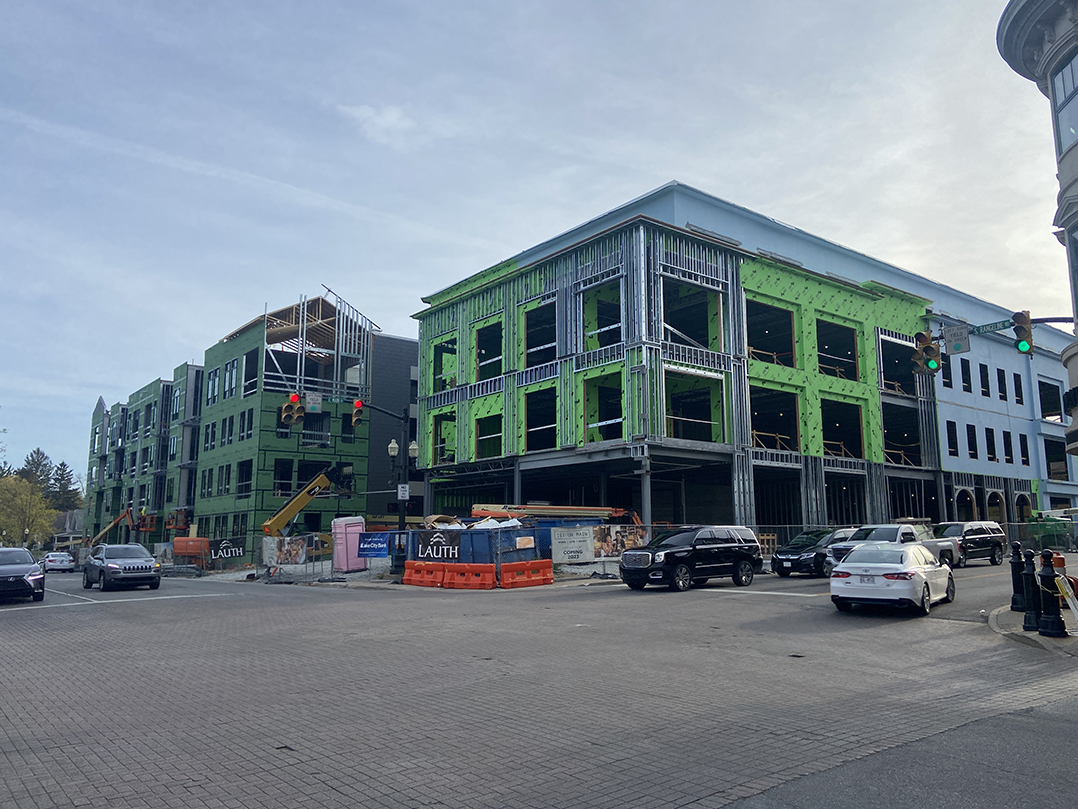When the Carmel Plan Commission met April 18, the only action item on its agenda included several variances and other matters concerning 1st on Main, a mixed-use development at one of the city’s most prominent intersections.
Commissioners approved six of the seven requests on first reading, but only after several said they felt they had little choice. The $40 million redevelopment project, which includes a four-story office building, 35 apartments and a public parking garage, has been under construction since mid-2022, with a well-established footprint making variance requests for increased lot coverage and reduced open space an apparent formality.
“The process that has brought us to this unfortunate set of seven questions has been followed as designed,” Plan Commission President Brad Grabow said. “Like the results or not, the project design has been approved, and the petitioner is complying with that. Some variances and waivers now are coming before us to essentially permit what is that horse that’s out of the barn. So, what I perceive is our frustration with the process is very valid, but not necessarily something that the petitioner has to bear at this point, because they followed the process that the city gave to them.”
Many commercial projects come before the plan commission for development plan (DP) and architectural design, lighting and sign (ADLS) approval, but because 1st on Main, a collaboration between Lauth Group and the Carmel Redevelopment Commission, is zoned C2, those approvals are handled by a single hearing officer.
Mike Hollibaugh, the director of Carmel’s Dept. of Community Services, served as the hearing officer and gave DP/ADLS approval for 1st on Main at a public hearing held April 14, 2022. According to meeting minutes, the approval was contingent on the petitioner providing city planners an updated site plan, receiving final approvals from the city’s engineering department and receiving approval on the lighting, bike and signage plan.
“The DP/ADLS was approved at (the) hearing with a condition that outstanding issues would be resolved satisfactorily,” Hollibaugh said April 26. “The DOCS staff and I believed the variances were reasonable and would be approved.”
Construction on the project began in late 2021, more than a year before developers submitted the variances and waivers that came before the plan commission in mid-April.
Hollibaugh said every development project in Carmel is unique and that it’s “not typical for construction to be far along” when variances are approved, such as in this case.
“We’re not stamping out widgets, but shaping a unique, special project with beautiful architecture and places for people,” Hollibaugh said. “A lot of thought and care goes into that effort by a number of people. Sometimes there are site issues, unique aspects of the project that don’t jive exactly with a (unified development ordinance) that was written largely for suburban style projects. It is not uncommon for development projects of all types to also require variance approvals, but normally they are heard by the Board of Zoning Appeals.”
At the April meeting, Commissioners Adam Aasen, who is also a member of the Carmel City Council, and Christine Zoccola requested the items be sent to the commission’s commercial committee for further review and to discuss the project’s approval process. After much discussion, the commission sent only one item – a variance to not include street trees with the project – to be heard by the committee.
Commissioner Leo Dierckman said sending most of the items to committee would be “highly inefficient” in a project already so far along.
“This cart is out of the barn, a long way down the road. I don’t disagree this is the most ridiculous process I’ve ever seen in 25 years of being on this dais in some form or another,” Dierckman said. “It’s a huge issue that we’ll never understand in one (committee) meeting, because there were a lot of assumptions that were made about this project.”
Hollibaugh said he intends to work alongside his planning staff to better communicate with plan commission members, especially regarding C2 projects.
“I was sorry that some commission members felt it was a negative situation; that’s on me,” he said. “I thought there was a better understanding of how our C-District redevelopment process works.”
Kevin Buchheit, a land use planner with Krieg DeVault, spoke on behalf of the petitioner at the plan commission meeting. He said 1st on Main is designed to “create place” using memorable dynamics.
“This is a recreation of an intense urban downtown area where it had not existed before,” Buchheit said. “I think the results of what has happened along the corridor over time are inarguably wonderful for the community overall.”
The commercial committee is set to meet at 6 p.m. May 4 at Carmel City Hall to discuss 1st on Main and other development projects.





